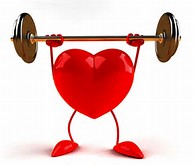
February is Heart Health Month, so I saw it very fitting to share a story with you involving my long-time client, Marty Witham.
Marty is 69 years young and trains with me two days a week, religiously. Recently, she started experiencing tightening in her chest after only six minutes on the treadmill, causing her to get off and sit until it passed. She made a call to her husband’s cardiologist (she had never had a need to go to one), and within a week, she had an appointment and stress test.
It was determined that she had a blockage and would need surgery. Six days later she had a stent placed in her LAD artery (known as the “Widow maker”) that was 90% blocked! I’m so happy to tell you, she came and trained with me today, eight days post surgery! She had so much more color, energy and pep than the previous couple of months.
Looking back, we did notice some symptoms that were slow to onset, including tiredness, dizziness, jaw and back pain, increase in blood pressure, shortness of breath and pale coloration.
Marty was unaware and shocked, as was I, with the diagnosis of the blockage and heart disease. We never suspected this type of heart blockage. I encourage you all to pay attention to your own body as well as your clients. Know the warning signs, as subtle as they may be. They are trying to tell you something. Women present differently than men, so knowing the signs is key to preventing a heart attack.
Marty’s cardiologist hold her it was a miracle she hadn’t had a heart attack already. Thank God she was proactive, and listened to her intuition.
Take a moment to read up on these important heart health facts and more importantly symptoms! It might save a client’s life!
Cheryl Schweitzer, CPT
Vital Fitness
HEART DISEASE FACTS
Heart disease is the number one cause of death for both men and women in the United States. It is an equal opportunity killer which claims approximately 1 million lives annually.
Women & Heart Disease
- Heart disease is the No. 1 killer of women, and is more deadly than all forms of cancer combined.
- While 1 in 31 American women dies from breast cancer each year, 1 in 3 dies of heart disease.
- Heart disease causes 1 in 3 women’s deaths each year, killing approximately one woman every minute.
- An Ninety percent of women have one or more risk factors for developing heart disease.
- The symptoms of heart disease can be different in women and men, and are often misunderstood.
Heart Attack Symptoms
Symptoms of a heart attack or myocardial infarction can vary greatly from person to person, but in order to help you identify a possible heart attack, we have listed some of the most common symptoms below:
- Approximately 2 out of every 3 people who have heart attacks experience chest pain, shortness of breath or fatigue a few days or weeks before the attack.
- A person with angina (temporary chest pain) may begin to find that it takes less and less physical activity to trigger the pain. Any change in the pattern of angina should be taken very seriously and brought to the attention of your physician.
- During a heart attack, a person may feel pain in the middle of the chest which can spread to the back, neck, jaw or arms. The pain may also be felt only in the back, neck, jaw or arms rather than the chest.
- A person having a heart attack may have gas-like pain or pressure in the stomach area which is often mistaken for indigestion. The pain is similar to angina, but it is usually more severe, longer lasting and does not improve with rest or a nitroglycerin pill.
- It is important to note that approximately 1 out of every 3 people who have heart attacks do not feel any chest pain. Many of these are women, non-Caucasian, older than 75, have heart failure or diabetes or have had a stroke.
- Nausea & vomiting which are sometimes mistaken for food poisoning or the stomach flu
- Lightheadedness or dizziness
- Shortness of breath, especially in older people
- Feelings of restlessness, sweatiness, anxiety or a sense of impending doom
- Bluishness of the lips, hands or feet
- Heavy pounding of the heart or abnormal heart rhythms
- Loss of consciousness (This can be the first symptom of a heart attack!)
- Disorientation resembling a stroke may occur in older people.
- Also, older people, especially women, will often take longer to admit they are not well and to request medical assistance.

